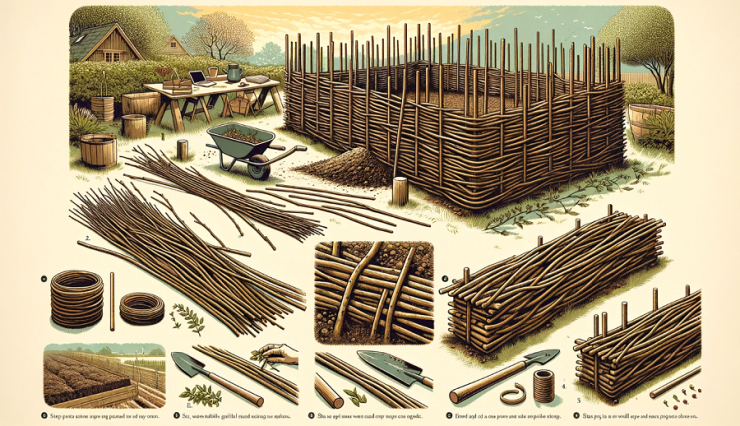Gardening is a timeless activity that not only brings joy but also serves as a source of fresh and healthy produce. If you’re looking to create a unique and sustainable garden bed, wattle raised garden beds might be just the solution you need. Wattle raised garden beds combine traditional craftsmanship with eco-friendliness, providing an aesthetically pleasing and functional addition to your garden. In this article, we will guide you through the steps of making your very own wattle raised garden bed.

What is a Wattle Raised Garden Bed?
A wattle raised garden bed is essentially a garden bed surrounded by a woven fence or barrier made from natural materials such as branches, twigs, and other flexible woody plant parts. This design offers several advantages:
Sustainable: Wattle garden beds make use of readily available, renewable resources from your garden, reducing the need for external materials.
Aesthetically pleasing: The woven pattern of the wattle fence adds a rustic and charming touch to your garden.
Enhanced protection: The wattle barrier can help keep out small animals and create a defined border for your garden.
Materials Needed
Before you start building your wattle raised garden bed, gather the necessary materials:
Wooden posts or stakes (for the corners and support)
Flexible branches, twigs, or willow rods
Pruning shears or a saw
Garden twine or natural cordage
Garden soil and compost
Plants or seeds of your choice
Steps to Make a Wattle Raised Garden Bed
Follow these steps to create your wattle raised garden bed:
Choose a location: Select a sunny spot in your garden with good drainage for your garden bed.
Determine the size: Measure and mark the dimensions of your garden bed. Use wooden posts or stakes to mark the four corners.
Prepare the soil: Remove any existing vegetation and loosen the soil in the designated area. Mix in compost to improve fertility.
Install corner posts: Drive wooden posts into the ground at each corner of your garden bed. These posts will serve as the support for your wattle fence.

Gather and prepare wattle materials: Collect flexible branches, twigs, or willow rods from your garden. Trim them to the desired length using pruning shears or a saw.
Weave the wattle fence: Starting at one corner post, weave the branches horizontally between the corner posts. Overlap the branches and secure them in place with garden twine or natural cordage. Continue weaving until you reach the desired height for your wattle fence. Repeat this process for each side of the garden bed.
Finish the wattle fence: Trim any excess branches and secure the ends by tucking them into the woven pattern or using additional cordage.
Fill the bed: Fill the wattle raised garden bed with a mixture of garden soil and compost. Ensure the soil level is even.
Plant your garden: Plant your chosen vegetables, herbs, flowers, or other plants in the wattle raised garden bed according to your preferences and gardening knowledge.
Care for your garden: Water, mulch, and maintain your garden bed as needed to help your plants thrive.
Creating a wattle raised garden bed is a rewarding and sustainable way to enhance your garden. The woven fence not only adds a unique aesthetic but also serves as a functional barrier for your plants. By using natural materials from your surroundings, you can reduce your environmental footprint while enjoying the benefits of a beautiful and productive garden bed. Give it a try and watch your garden flourish in your new wattle raised bed!
News
JJ Redick reacts to Luka Doncic trade for Anthony Davis
In one of the most jaw-dropping moves of the season, the NBA landscape was rocked by the blockbuster trade involving Luka Dončić and Anthony Davis—a swap that has sent ripples of excitement, disbelief, and heated discussion through the league. Among…
Anthony Davis FULL reaction to trade to Mavericks for Luka Doncic
In a blockbuster move that sent shockwaves through the NBA and left fans reeling, Anthony Davis has been traded to the Dallas Mavericks in exchange for Luka Dončić. In the immediate aftermath of the news, Davis took to the media…
Shaq reacts to Dallas Mavericks wanting Kevin Durant after Luka-AD trade 👀
In the constantly shifting world of the NBA, trade rumors and blockbuster moves are a regular part of the season’s drama. The latest twist has fans buzzing: the Dallas Mavericks have reportedly set their sights on acquiring Kevin Durant in…
Donovan Mitchell FILTHY poster dunk on Kristaps Porzingis 😳
In a game filled with high-intensity moments and jaw-dropping highlights, one play in particular has left fans and analysts buzzing about Donovan Mitchell’s latest display of athleticism. Early in the contest, with the atmosphere already charged by an evenly matched…
Joel Embiid hits go-ahead bucket vs Mavs then chats with Anthony Davis after game
In one of the most thrilling contests of the season, Joel Embiid delivered a clutch performance against the Dallas Mavericks, punctuating the game with a go-ahead bucket that sent the home crowd into a frenzy. The atmosphere in the arena…
D’Angelo Russell game winner as Nets hit two 3’s in 3 seconds to win vs Rockets 😱
In one of the most electrifying moments in recent NBA history, D’Angelo Russell delivered an unforgettable game-winner that left fans and commentators in complete awe. With the Brooklyn Nets locked in a tense battle against the Houston Rockets, the outcome…
End of content
No more pages to load











